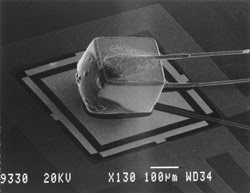Solid-state on-chip refrigerators promise applications in a variety of fields, including materials analysis and astronomy.
Anne L. Fischer, Senior Editor
Ultralow temperatures are required for a variety of next-generation sensors, but refrigeration techniques for reaching 0.1 K have been complicated and expensive. Now a group at the National Institute of Standards and Technology (NIST) in Boulder, Colo., and at the University of Notre Dame in Indiana has found that solid-state on-chip devices can cool the contents of a suspended dielectric membrane from 320 to 225 mK with enough extra cooling power to operate a range of cryogenic sensors.

The solid-state on-chip refrigerators cooled a germanium cube 11,000 times their size to approximately 200 mK.
Each refrigerator measures 25 × 15 μm and is based on quantum-mechanical tunneling of electrons through four pairs of normal metal-insulator-superconductor junctions. The junctions’ normal electrodes are aluminum doped with manganese, which suppresses the superconductivity of the normal metal. The temperature in the normal metal-insulator-superconductor junctions drops, and electronic and vibrational energy is drained from the objects being cooled. Designed like a sandwich with a normal metal and a superconducting metal on the outside and an aluminum-oxide insulator inside, the junctions are electrically connected in series and receive bias signals from a pair of control lines.
To test the power of these tunneling refrigerators, the researchers cooled thin-film and bulk payloads. The latter was a 250 × 250 × 250-μm cube of germanium glued to a silicon-nitride membrane. Despite being 11,000 times the size of the combined volume of the refrigerators, the cube was cooled to approximately 200 mK.
“That’s as if you reached out and cooled the Statue of Liberty, in terms of the size proportion,” said Joel N. Ullom, a physicist at NIST.
For nanotechnology to be relevant, it must connect to the macroscopic world. The tiny refrigerators span that distance with their ability to cool payloads with millimeter-scale dimensions.
With further improvements, the investigators believe that they can use the devices to double the temperature reduction and achieve temperatures of 100 mK or below. They also plan to integrate them with x-ray and far-IR sensors for industrial materials analysis and astronomy.
Ultimately, the researchers would like to simplify the devices so that other users can cool their own chips simply by clipping them to the NIST refrigerators.